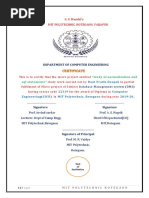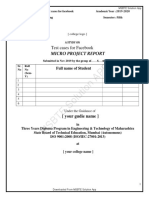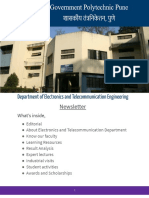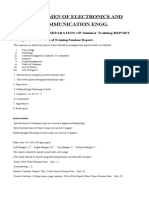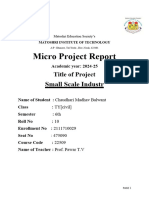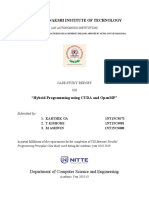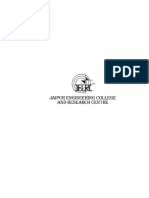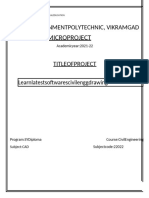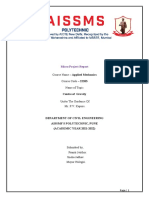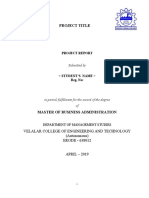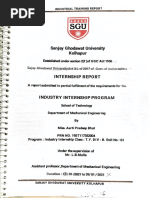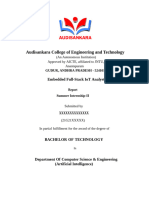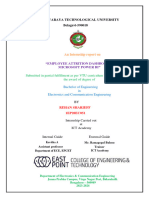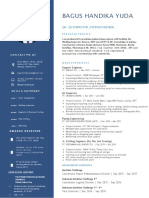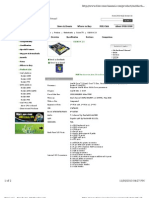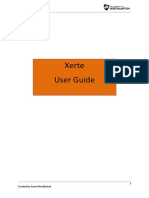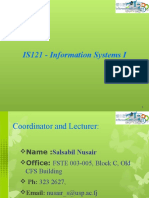MSBTE Solution APP: G. S. Mandal's Mit Polytechnic, Rotegaon, Vaijapur
MSBTE Solution APP: G. S. Mandal's Mit Polytechnic, Rotegaon, Vaijapur
Uploaded by
abhaybhavikatti643Copyright:
Available Formats
MSBTE Solution APP: G. S. Mandal's Mit Polytechnic, Rotegaon, Vaijapur
MSBTE Solution APP: G. S. Mandal's Mit Polytechnic, Rotegaon, Vaijapur
Uploaded by
abhaybhavikatti643Original Title
Copyright
Available Formats
Share this document
Did you find this document useful?
Is this content inappropriate?
Copyright:
Available Formats
MSBTE Solution APP: G. S. Mandal's Mit Polytechnic, Rotegaon, Vaijapur
MSBTE Solution APP: G. S. Mandal's Mit Polytechnic, Rotegaon, Vaijapur
Uploaded by
abhaybhavikatti643Copyright:
Available Formats
G. S.
Mandal`s
MIT POLYTECHNIC, ROTEGAON, VAIJAPUR
Project report
On
“Introduction to Cloud Computing ”
P
AP
Submitted in partial fulfilment of the requirements for the 5th semester
n
tio
Diploma in Computer Engineering
lu
So
For the Academic Year
2020-2021
TE
BY
SB
SHEWALE VISHAL ARVIND [1907770064]
M
UNDER THE GUIDANCE OF
Prof. Y.K.Dhotre,
Lecturer
Dept. of Computer Engg. & Technology,
MIT Polytechnic, Rotegaon
1|Page MIT POLYTECHNIC ROTEGAON
G. S. Mandal`s
MIT POLYTECHNIC, ROTEGAON, VAIJAPUR
DEPARTMENT OF COMPUTER ENGINEERING
This is to certify that project entitled “Introduction to Cloud Computing ” is a
P
AP
genuine academic work carried out by, SHEWALE VISHAL ARVIND in partial
fulfilment of Industrial Training (ITR) for the award of Diploma in Computer
Engineering ( CO5I) in MIT Polytechnic, Rotegaon during year 2020-21.
n
tio
_________________ _________________
lu
Signature Signature
So
Prof.Y.K.Dhotre, Prof. Arvind Sardar,
Lecturer.Dept of Comp Engg. Head Of Department[CO ]
TE
MIT Polytechnic, Rotegaon MIT,Rotegaon
SB
__________________________
M
Signature of Principal
Prof. K.S. patil
MIT Polytechnic,
Rotegaon.
Seal
of
Institute
2|Page MIT POLYTECHNIC ROTEGAON
Industrial Training is a golden opportunity for learning and self-
development. I consider myself very lucky and honoured to have so many
wonderful teachers guide me through in completion of this micro-project.
My grateful thanks to Prof. K. S. Patil , Principal MIT Polytechnic,
Rotegaon who in spite of being extraordinarily busy with his duties, took time
out to hear, guide and keep me on correct path. I do not know where I would
have been without him. A humble thank you sir.
P
AP
I would like to propose my vote of thanks to Prof. Arvind Sardar,
Head of Department [CO] who monitored my progress and arranged all facilities
n
to make my work easier and smoother. I choose this moment to acknowledge his
tio
contribution gratefully. Thank You Sir.
lu
So
Prof. Yogesh Dhotre Sir, Project Guide whose patience I have
probably tested to limit. He was always involved in the entire process and work
TE
of my micro-project, and shared his knowledge and encouraged me to think.
Thank You Sir.
SB
Last But not the least there were so many people my friends,
M
Teaching and non-teaching faculty who shared valuable information that helped
in the successful completion of this micro-project.
3|Page MIT POLYTECHNIC ROTEGAON
ANNEXURE II
Evaluation Sheet for the Industrial Training
Academic Year: 2020-21
Name: Industrial Training [ITR]
Semester: 5th
Title of Course: Introduction to Computer Computing.
Marks out of Marks out of
40 for 35 for
Total
Sr. performance performance
P
Student Name Out of
AP
No. in group in oral /
75
Activity presentation
n
(D5 Col. 8) (D5 Col. 9)
tio
1 SHEWALE VISHAL ARVIND
lu
So
TE
SB
M
4|Page MIT POLYTECHNIC ROTEGAON
INDEX
Sr.no. Content Page No.
1 Introduction 06
2 Week 1 06
3 Week 2 06
P
4 Week 3 07
5
AP 08
Week 4 n
tio
6 Conclusion 09
lu
So
TE
SB
M
5|Page MIT POLYTECHNIC ROTEGAON
CLOUD COMPUTING:-
Taught by: Rav Ahuja, Global Program Director,
IBM Skills Network Authorized by IBM.
WEEK 1:
Introduce to cloud computing:
In this lesson, you have learned:
Cloud computing is the delivery of on-demand computing resources over the
P
internet on a pay-as-you-go basis; resources are dynamically assigned and
reassigned among multiple users and scale up and down in response to users’
AP
needs.
The origins of cloud computing can be traced back to the mainframes of the
n
1950s, with virtualization technologies and hypervisors serving as catalysts for the
tio
emergence of modern-day cloud computing.
lu
Organizations must consider their business needs, investment viability, and risk
So
capacity in order to create a cloud adoption strategy that delivers desired benefits
without causing business disruptions and security, compliance, or performance
issues.
TE
Cloud adoption is growing faster than predicted. Driving this technological wave
are cloud service providers with a host of services ranging from Infrastructure,
SB
Platform, and Software services. Some major Cloud providers of our times include
AWS, Alibaba Cloud, Google, IBM, and Microsoft Azure.
M
Week 2:
Cloud Infrastructure:
In this lesson, you have learned:
Cloud infrastructure consists of data centers, storage, networking components, and
compute resources.
Virtualization is the process of creating a software-based version of physical
resources, made possible through the use of hypervisors.
6|Page MIT POLYTECHNIC ROTEGAON
A few different types of Virtual Machines can be provisioned on the cloud. These
include:
Shared or Public Cloud VMs that are provider-managed, multi-tenant deployments
that can be provisioned on-demand with predefined sizes
Transient or Spot VMs that take advantage of unused capacity in a cloud data
center
Reserved VMs that allow you to reserve capacity and guarantee resources for
future deployments
Dedicated hosts that offer single-tenant isolation
Bare metal servers are single-tenant physical servers that are dedicated to a single
customer. Bare metal servers fulfill the demanding needs of high-performance
computing (HPC) and data intense applications and are ideal for applications that have
a high degree of security or compliance requirements.
P
Networking capabilities in the cloud are delivered as a service rather than in the form
AP
of rack-mounted devices. Cloud resources, such as VMs (or VSIs), storage, network
connectivity, and load balancers, are deployed into subnets within Virtual Private
Clouds (VPCs). Using private and public subnets allows users to deploy multi-tier
n
enterprise applications securely. Load balancers distribute the traffic and allow
tio
applications to be responsive.
lu
Containers are an executable unit of software in which application code is packaged,
So
along with its libraries and dependencies, in common ways so that it can be run
anywhere—desktops, traditional IT, or the cloud. Containers are lighter weight and
consume fewer resources than Virtual Machines - helping streamline the development
TE
and deployment of cloud native applications.
Week 3 :
SB
Cloud Storage and Content Delivery Networks:
M
In this lesson, you have learned:
Cloud storage is available in four main types–Direct Attached, File, Block, and
Object Storage. These storage types differ in how they can be accessed, the
capacity they offer, how much they cost, the types of data they are best suited to
store, and their read-write speed.
Direct Attached (or Local) Storage is storage that is presented directly to a cloud-
based server and is effectively either within the host server chassis or within the
same rack.
File Storage is typically presented to compute nodes as a Network File System
(NFS), which means that the storage is connected to compute nodes over a
standard ethernet network.
7|Page MIT POLYTECHNIC ROTEGAON
Block Storage is presented to compute nodes using high-speed fiber connections,
typically provisioned in volumes, which are mounted onto a compute node.
Object Storage is accessed via an API and doesn’t need an underlying compute
node. Object Storage offers infinite capacity as you can keep adding files to it and
just pay for what you use. Compared to the other storage types, object storage is
slowest in terms of read and write speeds.
A Content Delivery Network (CDN) is a distributed server network that accelerates
internet content delivery by delivering temporarily stored or cached copies of
website or media content to users based on their geographic location.
Week 4 :
Cloud Native Applications, DevOps, and Application
Modernization:
P
AP
In this lesson, you have learned:
n
Cloud native applications are applications that are built or refactored to work in the
tio
cloud environment. These applications, developed using DevOps methodologies,
consist of microservices packaged in containers that can run in any environment—
lu
making it possible to create and update features in quick iterative cycles.
So
DevOps is a collaborative approach that enables development and operations
teams to continuously deliver software in quick iterative cycles while reducing
overhead, duplication, and rework. DevOps’ tools, practices, and processes help
TE
tackle the complexities and challenges posed by the cloud, allowing solutions to be
delivered and updated —quickly and reliably.
SB
Application Modernization helps organizations accelerate their digital
transformation, take advantage of new technologies and services, and become
M
more responsive to changing market dynamics. Cloud computing is one of the key
enablers of application modernization.
8|Page MIT POLYTECHNIC ROTEGAON
From this course I have been introduced to cloud computing, its infrastructure ,its models,
cloud storage and so on.The completion of this course makes me eligible to earn the
Cloud Computing Core IBM digital badge.
P
AP
n
tio
lu
So
TE
SB
M
9|Page MIT POLYTECHNIC ROTEGAON
You might also like
- G. S. Mandal's Mit Polytechnic, Rotegaon, Vaijapur: Department of Computer EngineeringDocument2 pagesG. S. Mandal's Mit Polytechnic, Rotegaon, Vaijapur: Department of Computer EngineeringKajal jainNo ratings yet
- STE Micro Project-1Document14 pagesSTE Micro Project-1dnyaneshwar kapseNo ratings yet
- Divy SPMDocument36 pagesDivy SPMAnmol KingNo ratings yet
- Introduction To I2EDocument8 pagesIntroduction To I2EyapchNo ratings yet
- NewsletterDocument18 pagesNewsletterPratik SabaleNo ratings yet
- Varma Internship Final SahithimamDocument26 pagesVarma Internship Final SahithimamUppalapati sai narendra VarmaNo ratings yet
- TE EXTC IA2 Digital CommunicationDocument4 pagesTE EXTC IA2 Digital Communicationmani siva 007No ratings yet
- Summer Trg-Seminar Report FormatDocument6 pagesSummer Trg-Seminar Report FormatRidhi JainNo ratings yet
- Micro Project Report: Small Scale IndustrDocument5 pagesMicro Project Report: Small Scale IndustrChetu DeoreNo ratings yet
- Nitte Meenakshi Institute of Technology: Department of Computer Science and EngineeringDocument5 pagesNitte Meenakshi Institute of Technology: Department of Computer Science and EngineeringKarthik GaNo ratings yet
- Department of Computer Science and Engineering Welcomes NBA Expert CommitteeDocument45 pagesDepartment of Computer Science and Engineering Welcomes NBA Expert Committeekotresh_hmkNo ratings yet
- Document 3Document33 pagesDocument 3MemoursNo ratings yet
- MP 816to820 AmeDocument18 pagesMP 816to820 AmeBajirao JetithorNo ratings yet
- Course Name - Applied Mechanics Course Code - 22203 Name of TopicDocument8 pagesCourse Name - Applied Mechanics Course Code - 22203 Name of TopicBajirao JetithorNo ratings yet
- Java WorkingDocument18 pagesJava Workingsmogarkar36No ratings yet
- Darpan Dohale Micro ProjectDocument23 pagesDarpan Dohale Micro Projectpranitdupare456No ratings yet
- Maharashtra State Board of Technical Education (Mumbai) : Inustrial Training Project ReportDocument15 pagesMaharashtra State Board of Technical Education (Mumbai) : Inustrial Training Project Reportharsh100% (1)
- Course Name - Applied Mechanics Course Code - 22203 Name of TopicDocument7 pagesCourse Name - Applied Mechanics Course Code - 22203 Name of TopicBajirao JetithorNo ratings yet
- VCET - MBA - Proj Report Format - 17-10-17Document8 pagesVCET - MBA - Proj Report Format - 17-10-17MehakNo ratings yet
- Fabrication of Silicon P-N Juction DiodeDocument4 pagesFabrication of Silicon P-N Juction DiodeKishan GadriNo ratings yet
- Maharashtra Board of Technical EducationDocument4 pagesMaharashtra Board of Technical EducationSumant MalganNo ratings yet
- Ajp RRRDocument17 pagesAjp RRRsmogarkar36No ratings yet
- Maharashtra Board of Technical EducationDocument5 pagesMaharashtra Board of Technical EducationSumant MalganNo ratings yet
- Maharashtra Board of Technical EducationDocument4 pagesMaharashtra Board of Technical EducationSumant MalganNo ratings yet
- Maharashtra Board of Technical EducationDocument4 pagesMaharashtra Board of Technical EducationSumant MalganNo ratings yet
- Industrial Report FormatDocument21 pagesIndustrial Report Formatlucifer 18No ratings yet
- Final - T.Y.B.Tech (Sem VI)Document33 pagesFinal - T.Y.B.Tech (Sem VI)vsvarnekar140No ratings yet
- Airline PredictionDocument32 pagesAirline PredictionUppalapati sai narendra VarmaNo ratings yet
- Final - T.Y.B.Tech (Sem V)Document29 pagesFinal - T.Y.B.Tech (Sem V)vsvarnekar140No ratings yet
- RGI-BOS-CE-1 (Before 19th BoS) (Old) - 1Document110 pagesRGI-BOS-CE-1 (Before 19th BoS) (Old) - 1Anshu Barmase100% (1)
- Maharashtra Board of Technical EducationDocument4 pagesMaharashtra Board of Technical EducationSumant MalganNo ratings yet
- DEMDocument18 pagesDEMKarthik OberioNo ratings yet
- Ranjana S. Baruah: P H O N E 91-7607524479 / E M AI L Eche120040@rgipt - Ac.in / W E BDocument1 pageRanjana S. Baruah: P H O N E 91-7607524479 / E M AI L Eche120040@rgipt - Ac.in / W E Branjana7123No ratings yet
- NSDC Embedded Full-Stack IoT AnalystDocument33 pagesNSDC Embedded Full-Stack IoT Analystvvasavi113No ratings yet
- Mit School of Architecture: MIT Art, Design and Technology University, Pune (India)Document8 pagesMit School of Architecture: MIT Art, Design and Technology University, Pune (India)Surabhi MendheNo ratings yet
- Final Year BTech Civil Syllabus R4 Acad Council Approved 2021Document84 pagesFinal Year BTech Civil Syllabus R4 Acad Council Approved 2021Ajay TichkuleNo ratings yet
- School of Engineering and Technology: A Dissertation Report OnDocument20 pagesSchool of Engineering and Technology: A Dissertation Report Onkarthik zeeNo ratings yet
- IVP 360S Subject Guide 2024 - V1Document7 pagesIVP 360S Subject Guide 2024 - V1Siliziwe DipaNo ratings yet
- SadgunDocument2 pagesSadgunYash ShindeNo ratings yet
- Abhishek Man Micro ProjectDocument26 pagesAbhishek Man Micro ProjectOM SUNIL AHERNo ratings yet
- Department of Mechanical Engineering: COURSE PLAN 2018-19Document58 pagesDepartment of Mechanical Engineering: COURSE PLAN 2018-19Rehan KMNo ratings yet
- Rehan Intership Final ReportDocument38 pagesRehan Intership Final Reportrehansharieff.2002No ratings yet
- Staff Appriasal Report PBKDocument7 pagesStaff Appriasal Report PBKpraveenkhatkaleNo ratings yet
- Kehinde CVDocument2 pagesKehinde CVIndra SaputraNo ratings yet
- Me 2020Document172 pagesMe 2020kedar pathakNo ratings yet
- NSDC Machine Learingn EngineerDocument29 pagesNSDC Machine Learingn Engineervvasavi113No ratings yet
- Curiculum Vitae - Bagus Handika Yuda - Inspector & EngineerDocument12 pagesCuriculum Vitae - Bagus Handika Yuda - Inspector & EngineerPRIMA JAYANo ratings yet
- Biju Patnaik University of Technology, Odisha: ResetDocument2 pagesBiju Patnaik University of Technology, Odisha: ResetKumar ChandanNo ratings yet
- Project-I 5th Sem ManualDocument15 pagesProject-I 5th Sem ManualHemant Kumar Sahu CSENo ratings yet
- Raksh InternDocument46 pagesRaksh Intern2BA19CV059 Rakshita SarangmathNo ratings yet
- BE Mechatronics 2015Document364 pagesBE Mechatronics 2015VIGNESH RAJ MNo ratings yet
- Project Exhibition Final 2Document183 pagesProject Exhibition Final 2Gem StonesNo ratings yet
- Fsi 4220Document31 pagesFsi 4220venkatasuryakamal08No ratings yet
- Micro Project Format - BCCDocument13 pagesMicro Project Format - BCCMoin PinjariNo ratings yet
- Annexure ADocument6 pagesAnnexure Ahaseeb khanNo ratings yet
- EnglishDocument4 pagesEnglishYash ParmarNo ratings yet
- Coc Revised Curriculum BS Accountancy Sy 2018 2019 Duly NotedDocument6 pagesCoc Revised Curriculum BS Accountancy Sy 2018 2019 Duly NotedJoseph Niño CuatonNo ratings yet
- Ankit AttendanceDocument1 pageAnkit Attendancefakeid2nd2048No ratings yet
- Training Facility Norms and Standard Equipment Lists: Volume 2---Mechatronics TechnologyFrom EverandTraining Facility Norms and Standard Equipment Lists: Volume 2---Mechatronics TechnologyNo ratings yet
- FoxconnMX K2.0 MotherboardDocument2 pagesFoxconnMX K2.0 MotherboardmaruthiganNo ratings yet
- Automated Malware Analysis Sans Fire 2009 2Document46 pagesAutomated Malware Analysis Sans Fire 2009 2jackivescNo ratings yet
- SIM Card Reg DocumentationDocument54 pagesSIM Card Reg Documentationanon-607553100% (4)
- Manual de Tablet Coby PDFDocument120 pagesManual de Tablet Coby PDFronald_ruiz3187No ratings yet
- PICAXE Exercise 3 - RTC, EEPROM, Temp LoggingDocument4 pagesPICAXE Exercise 3 - RTC, EEPROM, Temp LoggingproeproNo ratings yet
- Android Developer CVDocument5 pagesAndroid Developer CVNUN SinghNo ratings yet
- Cybersecurity ThreatsDocument10 pagesCybersecurity ThreatsИнна ЕлисееваNo ratings yet
- Xerte User V2 FinalDocument114 pagesXerte User V2 FinalJose M Mendoza RNo ratings yet
- Cryptography and The Smart GridDocument21 pagesCryptography and The Smart GridJoseph_NuamahNo ratings yet
- Circuit Identification Code Test (CIC Test) PresDocument15 pagesCircuit Identification Code Test (CIC Test) PresIslam Hasabo100% (1)
- Hvac Package e Module V1.40m3m+m1e - EngDocument25 pagesHvac Package e Module V1.40m3m+m1e - Engabdulyunus_amirNo ratings yet
- Google - Prep4sure - Professional Cloud Network Engineer - Sample.question.2023 Feb 25.by - Adam.80q.vceDocument17 pagesGoogle - Prep4sure - Professional Cloud Network Engineer - Sample.question.2023 Feb 25.by - Adam.80q.vceahme imtiazNo ratings yet
- PTQ Pdpmv1 User ManualDocument306 pagesPTQ Pdpmv1 User ManualRaiany Cavedini Rodolfo CavediniNo ratings yet
- MercusysDocument69 pagesMercusysOswaldo StellingNo ratings yet
- WM845G Formation Cics v5 Cicsplex System Manager Introduction PDFDocument1 pageWM845G Formation Cics v5 Cicsplex System Manager Introduction PDFCertyouFormationNo ratings yet
- Lesson 7 Communication ModesDocument8 pagesLesson 7 Communication ModesJenNo ratings yet
- Notes of 1st Module CYBER SPACEDocument57 pagesNotes of 1st Module CYBER SPACEAnonymous d3CGBMzNo ratings yet
- Facebook Emily FortisDocument2 pagesFacebook Emily Fortisapi-19940859No ratings yet
- Is121 W1 L1Document19 pagesIs121 W1 L1krishneelNo ratings yet
- APlus PDFDocument6 pagesAPlus PDFnirvana.7No ratings yet
- Clicking Clean 2017Document102 pagesClicking Clean 2017dreams24No ratings yet
- Computeractive - 4 January 2017Document76 pagesComputeractive - 4 January 2017frank_kokos100% (2)
- Sprint Samsung Epic ManualDocument268 pagesSprint Samsung Epic ManualWireflyNo ratings yet
- Ds-2Cd2646G2-Izsu/Sl: 4 MP Acusense Strobe Light and Audible Warning Motorized Varifocal Bullet Network CameraDocument6 pagesDs-2Cd2646G2-Izsu/Sl: 4 MP Acusense Strobe Light and Audible Warning Motorized Varifocal Bullet Network CameraRodolfo SouzaNo ratings yet
- (OLE For Process Control) Specification and Its DevelopmentsDocument4 pages(OLE For Process Control) Specification and Its DevelopmentsAulia RahmanNo ratings yet
- Server ConfigureDocument13 pagesServer ConfigureEndale GirumeNo ratings yet
- Elastix A2 BillingDocument5 pagesElastix A2 BillingdondegNo ratings yet
- Frequency Management and Channel AssignmentDocument36 pagesFrequency Management and Channel AssignmentMayank SharmaNo ratings yet
- WMN 1Document56 pagesWMN 1Shaikh WasimaNo ratings yet
- Catalog 2005Document52 pagesCatalog 2005marquarpNo ratings yet
